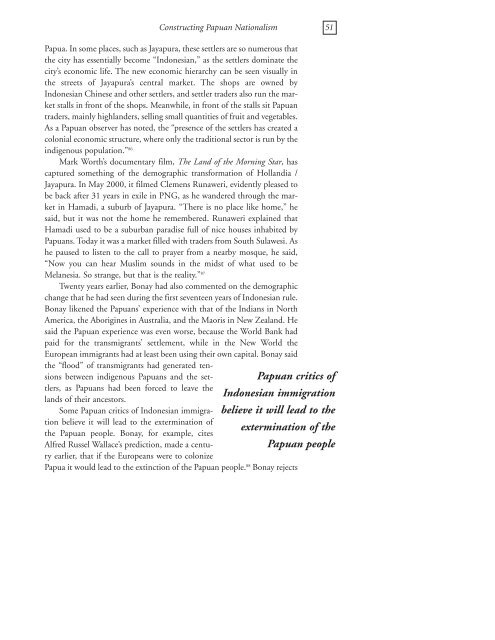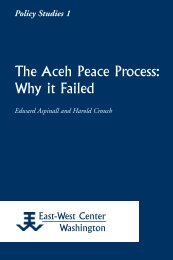Constructing Papuan Nationalism: History, Ethnicity ... - ScholarSpace
Constructing Papuan Nationalism: History, Ethnicity ... - ScholarSpace
Constructing Papuan Nationalism: History, Ethnicity ... - ScholarSpace
- No tags were found...
You also want an ePaper? Increase the reach of your titles
YUMPU automatically turns print PDFs into web optimized ePapers that Google loves.
<strong>Constructing</strong> <strong>Papuan</strong> <strong>Nationalism</strong> 51Papua. In some places, such as Jayapura, these settlers are so numerous thatthe city has essentially become “Indonesian,” as the settlers dominate thecity’s economic life. The new economic hierarchy can be seen visually inthe streets of Jayapura’s central market. The shops are owned byIndonesian Chinese and other settlers, and settler traders also run the marketstalls in front of the shops. Meanwhile, in front of the stalls sit <strong>Papuan</strong>traders, mainly highlanders, selling small quantities of fruit and vegetables.As a <strong>Papuan</strong> observer has noted, the “presence of the settlers has created acolonial economic structure, where only the traditional sector is run by theindigenous population.” 86Mark Worth’s documentary film, The Land of the Morning Star, hascaptured something of the demographic transformation of Hollandia /Jayapura. In May 2000, it filmed Clemens Runaweri, evidently pleased tobe back after 31 years in exile in PNG, as he wandered through the marketin Hamadi, a suburb of Jayapura. “There is no place like home,” hesaid, but it was not the home he remembered. Runaweri explained thatHamadi used to be a suburban paradise full of nice houses inhabited by<strong>Papuan</strong>s. Today it was a market filled with traders from South Sulawesi. Ashe paused to listen to the call to prayer from a nearby mosque, he said,“Now you can hear Muslim sounds in the midst of what used to beMelanesia. So strange, but that is the reality.” 87Twenty years earlier, Bonay had also commented on the demographicchange that he had seen during the first seventeen years of Indonesian rule.Bonay likened the <strong>Papuan</strong>s’ experience with that of the Indians in NorthAmerica, the Aborigines in Australia, and the Maoris in New Zealand. Hesaid the <strong>Papuan</strong> experience was even worse, because the World Bank hadpaid for the transmigrants’ settlement, while in the New World theEuropean immigrants had at least been using their own capital. Bonay saidthe “flood” of transmigrants had generated tensionsbetween indigenous <strong>Papuan</strong>s and the settlers,as <strong>Papuan</strong>s had been forced to leave thelands of their ancestors.Some <strong>Papuan</strong> critics of Indonesian immigrationbelieve it will lead to the extermination ofthe <strong>Papuan</strong> people. Bonay, for example, citesAlfred Russel Wallace’s prediction, made a centuryearlier, that if the Europeans were to colonizePapua it would lead to the extinction of the <strong>Papuan</strong> people. 88 Bonay rejects<strong>Papuan</strong> critics ofIndonesian immigrationbelieve it will lead to theextermination of the<strong>Papuan</strong> people
















